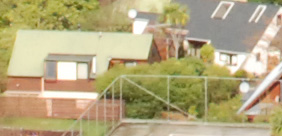Nikon D80 review
-
-
Written by Gordon Laing
Nikon D80 vs Canon EOS 400D / Rebel XTi real-life noise comparison
Nikon D80 results
Outdoor / Resolution / Noise / Noise 2
|
To compare noise levels under real-life conditions we shot the same scene using the Nikon D80 and Canon EOS-400D / Rebel XTi within a few moments of each other using their best quality JPEG options, Auto White Balance, default tone and sharpening, and at each ISO setting. The D80 was set to Matrix Metering and the Canon to Evaluative Metering. The D80’s High ISO Noise Reduction was set to its default Normal. Both cameras were fitted with their respective kit lenses: the DX 18-70mm for the Nikon and the EF-S 18-55mm for the Canon, each set to f11 in Aperture Priority mode; f11 was necessary due to the high brightness of the scene and the high ISOs in use. The crops are taken from an area just below and to the left of the centre. Note: as with our first outdoor results sample, the Canon 400D / XTi metered an exposure one stop darker than the D80. So for a level playing field here we’ve set the Canon to match the D80’s exposures using an EV compensation of +1. |
Nikon D80 with DX 18-70mm |
Canon EOS 400D with EF-S 18-55mm | |
 |  | |
| 18-70mm at 27mm, f11 (40mm equivalent) | 18-55mm at 25mm, f11 (40mm equivalent) |
Nikon D80 Using Nikkor DX 18-70mm f3.5-4.5 |
Canon EOS-400D / Rebel XTi Using Canon EF-S 18-55mm f3.5-5.6 | |
 |  | |
100 ISO, 1/60, f11 |
100 ISO, 1/60, f11 | |
 |  | |
200 ISO, 1/125, f11 |
200 ISO, 1/125, f11 | |
 |  | |
400 ISO, 1/250, f11 |
400 ISO, 1/250, f11 |
 |  | |
800 ISO, 1/500, f11 |
800 ISO, 1/500, f11 | |
 |  | |
1600 ISO, 1/1000, f11 |
1600 ISO, 1/1000, f11 |
 |  | |
H1.0 (3200 ISO), 1/2000, f11 |
3200 ISO not available |
|
From 100 to 400 ISO, both cameras deliver very clean results with little to tell their noise levels apart in real-life scenes. The biggest difference between the results is the extra detail resolved by the D80 thanks to its superior, albeit more expensive, lens. This is most apparent in foliage which on the 400D / XTi samples can appear quite fuzzy in comparison. Look out for outdoor comparisons made with higher quality lenses in a future article. With its default settings, the D80’s noise reduction noticeably kicks-in at 800 ISO with a little smearing of ultimate detail. The 400D / XTi 800 ISO result suffers from greater chroma noise, but contains a little more detail. Increasing to 1600 ISO sees noticeably less detail on both samples with more chroma noise on the 400D / XTi, and more smearing on the D80. This time the D80’s smearing has resulted in a slight posterised effect which can be seen on-screen at 100%; this can also be seen in our high ISO Gallery shots. Those who regularly shoot at high ISOs on the D80 may prefer to reduce its High ISO Noise Reduction from the default Normal setting to Low, or even off altogether. While we preferred the lower noise reduction and subsequently less smeared samples of the Canon 400D / XTi at high sensitivities, the D80 is at least adjustable in this respect. Either way. both cameras are capable of excellent performance at high sensitivities. You may also wish to compare results taken with the Sony Alpha A100 of the same section, albeit on a different day in our Sony Alpha A100 review. |
Nikon D80 versus Canon EOS 400D / Rebel XTi: JPEG versus RAW comparison
To compare the effect of in-camera processing and compression, we took the 100 ISO sample with each camera in their RAW plus Large Fine JPEG modes, and compared both files for each model below. At the time of writing, Adobe Camera RAW did not support the RAW files from either the D80 or 400D / XTi, so we used the Nikon Picture Project 1.7 and Canon Digital Photo Professional 2.2 software supplied with each camera to convert the RAW images. We used the default settings for both Picture Project and DPP, then transferred the data to Photoshop with 16-bit tonal depth before converting to 8-bit, then cropping and saving using the same settings as the JPEGs above. We will update this page when Adobe Camera RAW supports both cameras for consistency with our existing results. |
Nikon D80 with DX 18-70mm JPEG versus RAW | ||
 |  | |
Large Fine JPEG, 100 ISO, 1/60, f11 |
Nikon Picture Project 1.7 conversion, 100 ISO, 1/60, f11 | |
Canon EOS-400D / Digital Rebel XTi with EF-S 18-55mm JPEG versus RAW | ||
 |  | |
Large Fine JPEG, 100 ISO, 1/60, f11 |
Canon DPP 2.2 conversion, 100 ISO, 1/60, f11 | |
The processed RAW file from the D80 is slightly sharper and contains fractionally greater detail. This is most noticeable in the foliage of the bushes and trees, along with the court fencing and horizontal lines running across the lower wall in front of the house on the left. The processed RAW file from the EOS 400D / Rebel XTi at first glance appears sharper than the in-camera JPEG, but look a little closer and there’s undesirable artefacts especially around the fencing. As with the JPEG comparisons though, any extra detail on the Nikon samples is mostly down to the superior lens used. Check back soon for an outdoor comparison using prime lenses on each body. |




